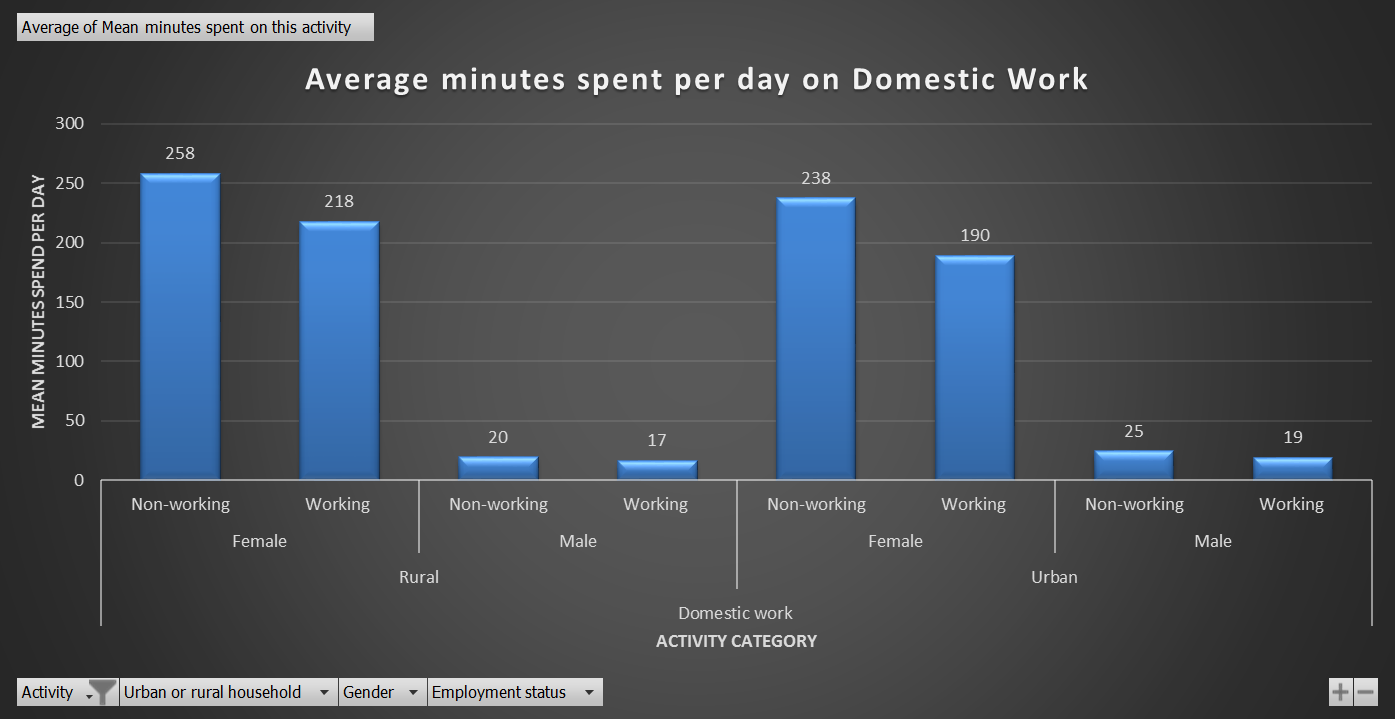Time Use Survey
December 10, 2019From our results, we see that females who live in rural areas of the country and are unemployed spend on average 258 minutes per day doing domestic work – more than any other observed category in our analysis.
The minimum amount of time spent doing domestic work (17 minutes) is of employed males living in the rural areas.
Our results show that females, irrespective of their employment status, spend more time on domestic work. This trend is similar in both rural and urban areas. Similarly, males, regardless of the regional area they are located in and their employment status report spending minimal time on household chores. This gives us a brief insight into the cultural quo in our country where domestic work is assumed to be the domain of the females, revealing gender inequality in terms of distribution of household chores.
CHILD CARE

Furthermore, we see that the trend in childcare is similar to that observed in domestic work - a female who lives in rural areas of the country and is unemployed spends on average 65 minutes per day on childcare whereas an unemployed male living in urban area has minimal contribution i.e. only 5 minutes per day on average.
We also see that males do not contribute much to child care in Pakistan. The reason for this trend can be pertained to the social and cultural norms of our society where child rearing is considered as the primary job of females.
Our findings also shed light on the factors contributing towards increased gender gap and low women empowerment. One of them being unequal distribution of domestic work and child care. This result is in accordance with the findings World Economic Forum (WEF)’s Gender Gap Index Report of 2018. 1
Males, regardless of the regional areas they are located in and their employment status, do not contribute towards the factors that take up a lot of time of women. Women, on average spend 303 minutes or more per day on domestic work and child care, factors that make no contribution towards the labor force and the real GDP of a country. This leaves little room for other factors including any form of employment and self-care.
HOUSEHOLD SIZE

Time Use Survey report further indicates that individuals, regardless of the categories they fall into based on gender, employment status and region, spend less time on childcare compared to domestic work. This trend converges as the household size increases. This indicates that large households, particularly joint family systems, have a more division of time spent on childcare and household chores, resulting in less time spent on these factors per person. It may be the case that one person does majority of the work but even in that case, the average remains small as other members of the family spend less time on these factors.
The highest amount of time spent on domestic work i.e. 150 minutes per day is observed in households that have a size of 2 individuals, whereas the highest amount of time spent in childcare i.e. 25 minutes is observed in households that have a size of 3.
INCOME WISE COMPARISON

Income wise comparison shows that the amount of time spent on domestic work remains more as compared to the time spent on childcare for both males and females.
For females, however, there is a huge difference in the amount of time spent on household chores and child care. Regardless of the income bracket women may fall in, they spend a lot more of their time on domestic work rather than on child care. One reason for this trend could be that large household sizes ease the burden of child responsibility on one person as was observed in the previous graph. Another reason to justify this trend could be that not all women have children.
Male, regardless of the income bracket they may fall into, spend little to no time on domestic work and child care. This shows that the time spent on these factors has little to do with the employment status, the income bracket, and the region a person lives in and has everything to do with gender. This signifies how impactful gender based discrimination is, in terms of gender roles in our society and how it is leading to low women empowerment and more gender inequality with time.
WORKS CITED
The Global Gender Gap Report, 2018. World Economic Forum. 279.
This blog post is written by Fizza Bokhari, Momina Kaleem, and Shahmeer Akhtar, students from the batch of 2020 at Lahore University of Management Sciences.
